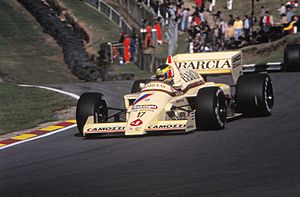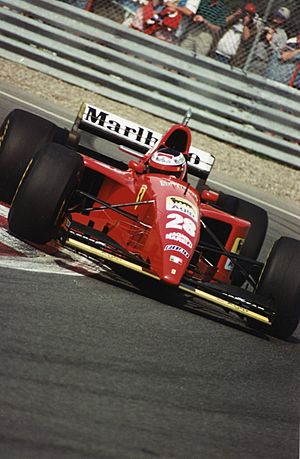Gerhard Berger facts for kids
Quick facts for kids
Gerhard Berger
|
|
|---|---|
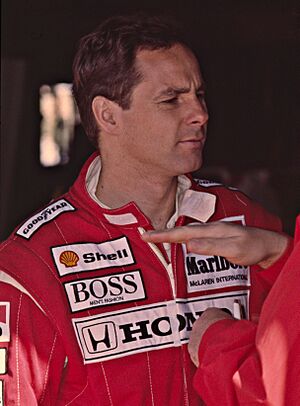
Berger at the 1991 United States Grand Prix
|
|
| Born | 27 August 1959 Wörgl, Tyrol, Austria
|
| Spouse(s) |
Ana Corvo
(m. 1995; div. 2013) |
| Children | 5 |
| Relatives | Lucas Auer (nephew) |
| Formula One World Championship career | |
| Nationality | |
| Active years | 1984–1997 |
| Teams | ATS, Arrows, Benetton, Ferrari, McLaren |
| Entries | 210 |
| Championships | 0 |
| Wins | 10 |
| Podiums | 48 |
| Career points | 385 |
| Pole positions | 12 |
| Fastest laps | 21 |
| First entry | 1984 Austrian Grand Prix |
| First win | 1986 Mexican Grand Prix |
| Last win | 1997 German Grand Prix |
| Last entry | 1997 European Grand Prix |
Gerhard Berger (born August 27, 1959) is a famous Austrian former racing driver. He was also a leader in motorsport after he stopped racing. Gerhard competed in Formula One (F1) from 1984 to 1997.
During his 14 seasons in F1, Berger won 10 Grand Prix races. He finished third overall in the championship twice, in 1988 and 1994, while driving for Ferrari. With 210 starts, he is one of the most experienced F1 drivers ever. His first and last wins were also the first and last for the Benetton team. He also won races with Ferrari and McLaren.
At McLaren, Berger was teammates with the legendary Ayrton Senna. Together, they helped McLaren win the constructors' titles in 1990 and 1991. Berger retired from racing in 1997. He had 10 wins, 12 pole positions (starting from the very front), 21 fastest laps, and 48 podium finishes (top three) in F1.
After retiring, Berger returned to F1 in 2006. He became a co-owner of the Toro Rosso team. He sold his share back to Red Bull at the end of the 2008 season.
Contents
Gerhard Berger's Racing Journey
Starting Out in Racing
Gerhard Berger was born in Wörgl, Austria. His father owned a truck company where Gerhard worked and later became a driver. Before F1, Berger was a multiple race winner in European Formula Three. He moved up to Formula One in 1984, driving for the ATS team.
Soon after starting in F1, Berger had a very serious car accident. A week after the 1984 season, he was driving home when his car was hit and went off a cliff. He wasn't wearing a seatbelt and was thrown from the car. Luckily, two surgeons specializing in back injuries were the first to arrive. They helped him safely until special equipment came. He had surgery for a broken neck and back injuries, but he made a full recovery.
In 1985, Berger drove a full season for Arrows. His car, the Arrows A8, wasn't the best, even with a powerful BMW M12 engine. He scored 3 points in the last two races, finishing 20th overall.
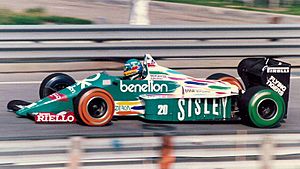
His F1 career really took off when he joined Benetton in 1986. He finally had a car that matched his talent and the powerful BMW turbo engine. With smart tire choices, Berger won his first Grand Prix in Mexico using the Benetton B186. He was also leading his home race in Austria but had to stop due to a flat battery. Berger was known for his speed, reaching an amazing 351.22 km/h (218.23 mph) at the Italian Grand Prix at Monza. This is still the fastest speed by a turbocharged car from that era.
Berger also raced in Group A touring car races. In 1985, he won the Spa 24 Hours race with teammates Roberto Ravaglia and Marc Surer. It was common for F1 drivers to race in other series back then. However, by 1985, F1 drivers needed special permission to race in other categories within 24 hours of a Grand Prix.
Driving for Ferrari
For the 1987 season, Berger joined Ferrari. He had a tough start with mechanical problems. But in the second half of 1987, he became very strong, winning the last two races of the season. The 1987 Ferrari F1/87 car was much better. Berger took pole position and won in both Japan and Australia. These wins gave Ferrari and Berger a lot of confidence for the 1988 championship.
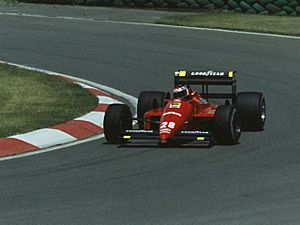
In 1988, the McLaren team, with Alain Prost and Ayrton Senna, dominated F1. They won 15 out of 16 races. Berger was the only driver to break McLaren's winning streak. He won the Italian Grand Prix after Senna had a crash. This was a very special win for Ferrari, as it happened just weeks after the death of Enzo Ferrari, the company's founder. Berger also took pole position at the British Grand Prix.
The Ferrari car in 1988 had some issues, especially with fuel use. Berger and his teammate often had to drive slower to save fuel. This meant they couldn't always use the car's full power. Berger estimated he could only use about 550 horsepower out of 650 horsepower if he wanted to finish a race.
In 1989, Nigel Mansell joined Berger at Ferrari. Their car, the Ferrari 640, was fast but often broke down. It had a new semi-automatic gearbox. Berger had a very scary crash at the San Marino Grand Prix. He hit a wall at almost 180 mph, and his car caught fire. It took 16 seconds for rescue workers to put out the fire. Amazingly, he only suffered burns to his hands and some broken ribs. He was back racing at the Mexican Grand Prix after missing just one race. Berger believed the new semi-automatic gearbox helped him recover faster.
Despite reliability issues, Berger finished second at the Italian Grand Prix. He then won the next race in Portugal and finished second in Spain. These were his only points for the year, but they still placed him 7th in the championship. Later that year, it was announced that Alain Prost would join Ferrari. Berger decided to move to McLaren, which was the fastest team at the time.
Time at McLaren
From 1990 to 1992, Berger was teammates with Ayrton Senna at McLaren. Many people expected Berger to challenge for the world championship. He was often as fast as Senna in qualifying, starting second behind him many times. However, he usually couldn't match Senna's speed during the races. He won three races during these three seasons. Senna even let him win the 1991 Japanese Grand Prix. Berger also won in Canada and Australia in 1992.
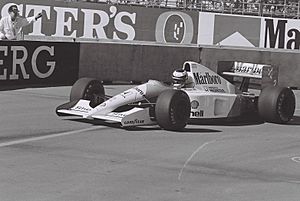
In 1990, Berger surprised everyone by taking pole position at the 1990 United States Grand Prix, ahead of Senna. He didn't win a race that year, but Senna won the championship. Towards the end of 1991, Berger felt more comfortable in the McLaren MP4/6 car. He out-qualified Senna in several races, taking pole position in Spain and Japan.
In 1992, Berger won the 1992 Canadian Grand Prix. He also won the Australian Grand Prix after a close fight. This was his last win for McLaren and McLaren's last race with Honda engines. Berger decided to return to Ferrari after receiving a good offer. McLaren mechanics even nicknamed him "Gearhard" because he broke more gearboxes than Senna!
Back at Ferrari
Ayrton Senna and Niki Lauda convinced Berger to return to Ferrari in 1993. They felt his experience with Senna would be valuable. The 1993 Ferrari F93A car was hard to drive and didn't win any races. Berger's best finish was third place at the 1993 Hungarian Grand Prix. He had some dramatic incidents, including a crash at the 1993 Portuguese Grand Prix.
In 1994, Berger faced a very sad year with the deaths of his close friend Senna and fellow Austrian Roland Ratzenberger at the 1994 San Marino Grand Prix. He scored an emotional win at Hockenheim for the 1994 German Grand Prix. This was Ferrari's first win since 1990. Berger also took two pole positions that year.
His final season with Ferrari in 1995 saw him on the podium several times. He was in a position to win the 1995 San Marino Grand Prix but stalled in the pits. He showed great racing skill, like an amazing pass on Damon Hill in Canada. At Monza, both Ferrari cars were fighting for the win when a camera from Jean Alesi's car fell off and damaged both cars, forcing them to retire. Berger and Alesi both left Ferrari for Benetton after this season.
Last Seasons with Benetton
In 1996, Berger moved back to Benetton. The team wasn't as competitive as before. Berger could have stayed at Ferrari, but he thought their new engine would take too long to develop. He spent his last two years in F1 with Benetton. 1996 was a tough season for him. He almost won the German Grand Prix again, but his engine broke down.
The 1997 season started slowly for Benetton. But Berger bounced back, finishing second at the 1997 Brazilian Grand Prix. He then scored Benetton's final Grand Prix victory at the age of 37, again at Hockenheim. This win came after he had surgery and his father passed away. He also took pole position and the fastest lap at that race. Berger announced he would retire at the end of the season. His final race saw him finish a close fourth in Jerez.
Fun Times and Pranks
Berger and Senna's Pranks
When Berger was at McLaren (1990–1992), he became famous for his funny side. He loved playing practical jokes on his serious teammate, Ayrton Senna. Senna also enjoyed the challenge, and their pranks grew bigger and bigger, encouraged by their team manager Ron Dennis.
One story tells of a time at Monza. Senna was showing off his new, super-strong briefcase made of carbon fiber. Berger opened the helicopter door and threw the briefcase out! Berger said he just wanted to test if it was really indestructible.
Berger also shared a story from before the 1990 Australian Grand Prix. After dinner, people were throwing each other into the swimming pool. Berger escaped, but Senna ran away to avoid getting wet. Later, Berger went to Senna's room, and Senna threw a glass of water at him. Berger, being from Austria, thought this was a challenge. So, at three in the morning, he and some friends used a fire extinguisher hose to spray water under Senna's door. Senna "flew out of the window like a rocket" because of the water! It woke up many people, who then complained to Senna for the noise.
In an Australian hotel, Berger filled Senna's bed with frogs. When an angry Senna confronted him, Berger calmly asked, "Did you find the snake?" Senna got him back by putting smelly French cheese in Berger's air conditioning unit.
Another time, Senna and Maurício Gugelmin filled Berger's shoes with shaving foam on a train. Berger had to go to a fancy dinner wearing a tuxedo with running shoes! In another prank, Berger replaced Senna's passport photo with a silly picture. Senna was so famous that his passport was rarely checked. But on a trip to Argentina, this prank caused officials to hold Senna for 24 hours! Senna got revenge by supergluing all of Berger's credit cards together.
Berger and Senna had a very strong friendship. After Senna's death in 1994, Berger became an advisor to Bruno Senna, Ayrton's nephew, who later became an F1 driver.
Other Pranks
Berger's pranks continued when he returned to Scuderia Ferrari in 1993. One day, at the Fiorano Circuit, before a new F1 car was launched, Berger and his new teammate, Jean Alesi, decided to take a nearby car for a spin. They didn't know it was team director Jean Todt's brand new special car. Berger pulled the handbrake, and the car flipped upside down, landing very close to their new F1 car! Alesi had to go to the hospital. When Todt asked about his car, Berger just said they put "slight curb marks on the roof."
After Racing
Gerhard Berger was a very popular person in Formula One. After retiring from racing, he became the Competitions Director at BMW until 2003. He helped BMW return to F1 successfully in 2000.
Berger was the first person to drive an F1 car on the new Shanghai Grand Prix circuit in 2003. On April 25, 2004, ten years after Ayrton Senna's death, Berger drove Senna's 1985 Lotus Renault 97T car for three laps at Imola.
In 2006, he bought 50% of Scuderia Toro Rosso. His team won their first Grand Prix with Sebastian Vettel in 2008. He sold his share back to Red Bull in November 2008. From 2012 to 2014, Berger was the President of the FIA Single Seat Commission. In 2017, he became chairman of ITR, which promotes the Deutsche Tourenwagen Masters racing series.
Berger's Helmet Design

Berger's helmet usually had a blue base with yellow lines and light blue and white details near the visor. In 1986, he used a different design that matched the colors of his Benetton BMW car. In 1987, his helmet was dark grey-blue with the Austrian flag on the sides.
For the 1995 Portuguese Grand Prix, Berger wore a special helmet. It had flags from many nations and "NO WAR IN THE WORLD" written on the back. This design was chosen from a competition. In 1996, he changed his original design slightly, rotating the Austrian flag horizontally.
Career Summary
| Season | Series | Team | Races | Wins | Poles | F/Laps | Podiums | Points | Position |
|---|---|---|---|---|---|---|---|---|---|
| 1982 | German Formula Three | Josef Kaufmann Racing | 10 | 0 | 0 | 0 | 2 | 83 | 3rd |
| European Formula Three | 3 | 0 | 0 | 0 | 0 | 0 | NC | ||
| 1983 | European Formula Three | MC Motorsport | 11 | 0 | 0 | 1 | 3 | 18 | 7th |
| Macau Grand Prix | Trivellato Racing | 1 | 0 | 0 | 1 | 1 | N/A | 3rd | |
| 1984 | European Formula Three | Trivellato Racing | 11 | 2 | 1 | 1 | 7 | 49 | 3rd |
| Formula One | ATS Wheels | 4 | 0 | 0 | 0 | 0 | 0 | NC | |
| Interserie | URD Rennsport | 1 | 0 | 0 | 0 | 0 | 8 | 31st | |
| European Touring Car Championship | Schnitzer Motorsport | 5 | 0 | 0 | 0 | 0 | 0 | NC | |
| 1985 | Formula One | Barclay Arrows BMW | 16 | 0 | 0 | 0 | 0 | 3 | 20th |
| Deutsche Tourenwagen Meisterschaft | Schnitzer Motorsport | 1 | 0 | 0 | 0 | 0 | 11 | 30th | |
| European Touring Car Championship | 6 | 1 | 0 | 0 | 1 | 29 | NC | ||
| World Sportscar Championship | Brun Motorsport | 1 | 0 | 0 | 0 | 0 | 6 | 56th | |
| 1986 | Formula One | Benetton BMW Team | 16 | 1 | 0 | 2 | 2 | 17 | 7th |
| European Touring Car Championship | Schnitzer Motorsport | 7 | 2 | 0 | 0 | 2 | 58 | NC | |
| 1987 | Formula One | Ferrari | 16 | 2 | 3 | 3 | 3 | 36 | 5th |
| 1988 | Formula One | Ferrari | 16 | 1 | 1 | 3 | 5 | 41 | 3rd |
| 1989 | Formula One | Ferrari | 15 | 1 | 0 | 1 | 3 | 21 | 7th |
| 1990 | Formula One | Honda Marlboro McLaren | 16 | 0 | 2 | 3 | 7 | 43 | 4th |
| 1991 | Formula One | Honda Marlboro McLaren | 16 | 1 | 2 | 2 | 6 | 43 | 4th |
| 1992 | Formula One | Honda Marlboro McLaren | 16 | 2 | 0 | 2 | 5 | 49 | 5th |
| 1993 | Formula One | Scuderia Ferrari | 16 | 0 | 0 | 0 | 1 | 12 | 8th |
| 1994 | Formula One | Scuderia Ferrari | 16 | 1 | 2 | 0 | 6 | 41 | 3rd |
| 1995 | Formula One | Scuderia Ferrari | 17 | 0 | 1 | 2 | 6 | 31 | 6th |
| 1996 | Formula One | Mild Seven Benetton Renault | 16 | 0 | 0 | 1 | 2 | 21 | 6th |
| 1997 | Formula One | Mild Seven Benetton Renault | 14 | 1 | 1 | 2 | 2 | 27 | 5th |
|
|
|||||||||
See also
 In Spanish: Gerhard Berger para niños
In Spanish: Gerhard Berger para niños


